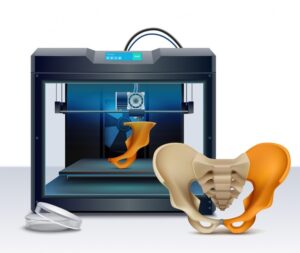The Renaissance of Medicine: Unveiling the Augmented Frontier of Healthcare through 3D Printing
The field of healthcare has always been at the forefront of technological advancements, continuously striving to improve patient outcomes and enhance quality of life. One such groundbreaking innovation that has gained tremendous momentum in recent years is 3D printing technology. By harnessing the power of additive manufacturing, 3D printing has revolutionized various industries, and healthcare is no exception.
A Brief Overview of 3D Printing Technology
At its core, 3D printing is a process that allows for the creation of three-dimensional objects by layering materials in a controlled manner based on a digital model or blueprint. Unlike traditional manufacturing methods that involve subtractive techniques like cutting or drilling, 3D printing builds objects layer by layer, offering unparalleled precision and customization.
Using specialized computer-aided design (CAD) software, healthcare professionals can create intricate models with incredible detail, capturing the intricacies of anatomical structures or medical devices. These designs are then converted into instructions for the 3D printer to follow, resulting in the physical realization of these digital concepts.
The Importance of Healthcare Advancements in Society
Advancements in healthcare have always played a pivotal role in shaping society as they directly impact human well-being and quality of life. From extending lifespans to improving treatment outcomes and enhancing patient comfort, each breakthrough brings us closer to achieving optimal health for all.
In this context, the emergence and advancement of 3D printing technology hold immense promise for transforming medical practice as we know it. By enabling personalized solutions and precise interventions tailored to individual patients’ needs, this revolutionary technology has opened up new horizons for healthcare professionals.
The potential implications are vast – from creating patient-specific implants to generating artificial organs for transplantation. With each step forward in utilizing this innovative technique effectively, healthcare practitioners can offer more accurate diagnoses, more effective treatments, and more seamless surgical procedures.

The Concept of 3D Printing in Healthcare
A Revolutionary Technological Marvel
At its core, 3D printing is a cutting-edge technology that involves the creation of three-dimensional objects by layering materials based on a digital model. Also known as additive manufacturing, this groundbreaking technique has made considerable strides and is transforming various industries.
In healthcare, the concept of 3D printing holds immense promise due to its ability to generate highly precise and personalized medical solutions. By utilizing specialized software and advanced hardware, healthcare professionals can now translate intricate patient data into tangible objects with remarkable accuracy.
Empowering Innovations in Medical Science
The evolution of 3D printing in the healthcare industry has been nothing short of extraordinary. Initially utilized for creating prototypes and models for research purposes, it soon became apparent that this technology had far-reaching potential within the field of medicine. Over time, innovative applications emerged, including the production of patient-specific medical devices and implants tailored to unique anatomies.
The ability to bio-print organs and tissues further revolutionized regenerative medicine and transplant surgery. Moreover, surgical planning and training tools derived from 3D printing are enhancing precision in the operating room while reducing risks for patients.
Milestone Adoption Across Healthcare Disciplines
The adoption of 3D printing within the healthcare industry has witnessed significant growth over recent years. Orthopedics was among the first specialties to embrace this technology, leveraging it to develop custom-made orthotics and prosthetics that fit seamlessly with patients’ bodies.
As knowledge expanded, applications extended into areas such as cranial implants for neurosurgery or facial reconstruction following trauma or cancer treatments. Additionally, dentistry embraced this transformative technique by fabricating dental crowns, bridges, aligners, and even complete jaw structures using biocompatible materials.
The adoption of 3D printing is not limited to surgical interventions alone. Research laboratories employ this technology to create anatomical models for studying specific diseases, improving the understanding of complex anatomical structures, and designing new drug delivery systems.
Today, the concept of 3D printing has become an integral tool for healthcare professionals across multiple disciplines. As technology continues to advance, its potential to reshape the landscape of medicine becomes increasingly evident

Revolutionary Applications of 3D Printing in Healthcare
Patient-Specific Medical Devices
Under this category, one of the most remarkable contributions of 3D printing technology in healthcare lies in the creation of customized prosthetics and orthotics. Traditionally, prosthetic limbs or orthotic devices were manufactured using standardized templates that often didn’t perfectly match the unique requirements of individual patients.
However, with the advent of 3D printing, clinicians can now design and fabricate patient-specific devices that fit like a glove and offer superior comfort and functionality. This has significantly improved the quality of life for individuals with limb loss or musculoskeletal conditions.
Moreover, 3D printing has revolutionized the field of implants and surgical instruments by enabling their customization according to each patient’s anatomy. Implants such as hip replacements, cranial plates, and dental implants can be precisely tailored to fit a patient’s specific anatomical structure.
This customization not only enhances implant stability but also reduces post-operative complications. Additionally, surgical tools can now be manufactured with intricate designs that perfectly align with a surgeon’s preferences and surgical technique, ensuring optimal precision during procedures.
Organ and Tissue Engineering
The realm of organ transplantation has been transformed by 3D printing technology through a process known as bio-printing. Bio-printing involves layer-by-layer deposition of bio-ink composed of living cells to construct functional organs suitable for transplantation. While still in its early stages, researchers have made astounding progress in bio-printing organs like kidneys, liver tissues, heart valves, and even small-scale vascular networks.
In addition to organ transplantation advancements, 3D bioprinting enables the development of artificial tissues for research purposes. Researchers can replicate complex tissue architectures using bio-inks containing various cell types arranged precisely to mimic natural structures accurately.
These fabricated tissues serve as invaluable models for studying diseases, testing drug efficacy, and unraveling intricate biological processes. Furthermore, these artificial tissues have the potential to eliminate the need for animal testing in drug development and toxicity studies, thus making research more ethical and efficient.
Surgical Planning and Training Tools
The utilization of 3D printing technology for the creation of anatomically accurate models has revolutionized surgical planning. Surgeons can now obtain patient-specific replicas of anatomical structures such as bones, organs, or blood vessels by converting medical imaging data into 3D printable models. By having a tangible model in hand, surgeons can better understand complex pathologies and plan surgical interventions with enhanced precision.
This preoperative planning significantly reduces intraoperative surprises, improves surgical outcomes, and decreases operative time. In addition to planning tools, 3D printing has also opened up new possibilities for simulation training in surgery.
Surgeons can practice on patient-specific replicas that accurately mimic tissue properties and enable realistic simulations of various procedures. This form of advanced training allows surgeons to refine their skills without risking patient safety during live surgeries.
Simulation-based training using 3D printed replicas enhances surgical competence and ensures that surgeons are well-prepared to handle complex cases. Overall, the incorporation of 3D printing technology in healthcare has not only transformed patient-specific medical devices but has also revolutionized organ transplantation possibilities through bio-printing techniques.
Furthermore, it has facilitated precise surgical planning through anatomically accurate replicas while enabling realistic simulation-based training for surgeons. With continued advancements in this field, 3D printing is poised to play an increasingly significant role in shaping the future of healthcare by providing personalized solutions that improve patient outcomes while pushing the boundaries of medical innovation.
Advantages and Limitations of 3D Printing in Healthcare
AdvantagesPersonalized patient care: Redefining Treatment Paradigms
The integration of 3D printing in healthcare has paved the way for personalized patient care, revolutionizing treatment approaches. One significant advantage lies in improved treatment outcomes. By leveraging the ability to create patient-specific medical devices, such as customized prosthetics or orthotics, healthcare professionals can ensure a perfect fit and tailored solution for each individual.
This not only enhances patient comfort and satisfaction but also contributes to better treatment outcomes, as these personalized devices often lead to improved functionality and increased mobility for patients. Furthermore, the customization of implants and surgical instruments based on anatomical data allows surgeons to perform procedures with greater precision, further reducing potential complications.
Moreover, 3D printing offers substantial time and cost savings within the healthcare system. The reduction in surgery duration is a notable advantage resulting from preoperative planning using anatomically accurate models created through 3D printing.
Surgeons can study intricate details of a patient’s anatomy before entering the operating room, allowing them to anticipate challenges and streamline their approach. This leads to shorter surgery times, minimizing the risk of complications during procedures as well as reducing overall healthcare costs.
Eliminating or reducing the need for multiple surgeries is another significant benefit brought forth by 3D printing technology. By creating precise models that simulate a patient’s unique anatomy, surgeons can accurately plan complex procedures.
This capability helps minimize errors during surgery, reducing the likelihood of subsequent corrective surgeries or revisions. Additionally, 3D printing enables lower production costs for medical devices compared to traditional manufacturing methods.
By producing complex medical devices on-demand using additive manufacturing techniques instead of traditional subtractive methods like milling or casting, economies of scale are achieved while maintaining product quality. This cost-effectiveness translates into improved access to advanced medical technologies for patients worldwide.
LimitationsUnveiling Regulatory and Material Challenges
While the advantages of 3D printing in healthcare are undeniable, it is crucial to acknowledge the existing limitations and challenges inherent in this rapidly evolving field. Regulatory challenges pose significant obstacles to the widespread adoption of 3D-printed medical devices. The approval process for these devices requires scrutiny by regulatory agencies to ensure safety, efficacy, and adherence to strict quality standards.
This process can be time-consuming, hindering rapid implementation of innovative technologies in clinical practice. Ethical considerations surrounding organ transplantation using 3D printing techniques also present a pressing challenge.
While bio-printing offers hope for addressing organ shortages, ethical debates arise regarding issues such as consent for using human cells, equitable organ distribution, and even questions around the creation of artificial organs with enhanced capabilities that may blur the boundaries between human and machine. Material limitations constitute another hurdle in unlocking the full potential of 3D printing in healthcare.
The availability and compatibility of suitable materials for different applications remain a challenge. Ensuring biocompatibility is crucial when creating implants or tissue substitutes that interact with the patient’s body.
Additionally, long-term durability poses concerns as printed materials must withstand mechanical stressors over extended periods without deterioration or degradation. Acknowledging these limitations is fundamental as they highlight areas where further research and development are necessary to optimize 3D printing technology’s integration into mainstream healthcare while ensuring patient safety, ethical integrity, and long-term effectiveness.
Current Examples & Case Studies
Patient-Specific Implants: Titanium Jaw Replacement Case Study
In a groundbreaking case, 3D printing technology has been employed to create patient-specific implants for individuals requiring jaw replacements. One remarkable example is the story of John, a car accident survivor who suffered severe facial injuries resulting in the loss of a significant portion of his lower jaw.
Traditional prosthetic options were limited in their ability to restore both functionality and aesthetics. However, with the advent of 3D printing, surgeons were able to create a meticulously customized titanium jaw implant that perfectly matched John’s anatomy.
The implant was designed based on precise measurements obtained from CT scans and 3D models of his skull. This innovative solution not only restored John’s ability to eat and speak comfortably but also drastically improved his overall quality of life.
Organ Transplantation: Advancements Through 3D Printing
The field of organ transplantation has experienced significant advancements through the utilization of 3D printing technology. One notable example is the development of bio-printing techniques that aim to address the critical shortage of organs available for transplantation. By using specialized bio-ink composed of living cells, scientists are now able to print three-dimensional structures that mimic human organs’ complexity and functionality.
These bio-printed organs hold immense potential in revolutionizing transplantation procedures by eliminating long waiting lists and reducing organ rejection rates significantly. Moreover, researchers have successfully printed miniature functional liver tissue for pharmaceutical testing purposes, enabling more accurate drug development and greater understanding of disease mechanisms.
Conclusion
As we reflect on the current state and prospects, it becomes unequivocally clear that 3D printing has emerged as a transformative force within healthcare realm. Its applications range from patient-specific medical devices to organ engineering advancements that were once considered science fiction.
By harnessing this cutting-edge technology, healthcare professionals can provide personalized care, enhance treatment outcomes, and streamline surgical procedures. Although certain challenges remain, such as regulatory hurdles and material limitations, the potential benefits of 3D printing in healthcare are immense.
With further advancements and continued research, a future where customized organs and medical devices are readily accessible to all may not be too far away. Embracing this technological marvel allows us to forge a path towards a brighter future where the possibilities of healing and improving lives are boundless.




